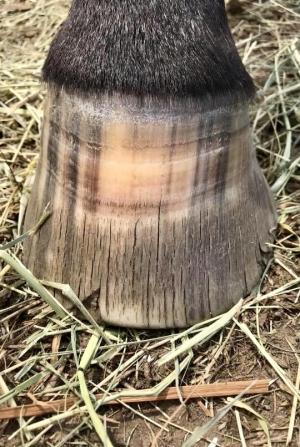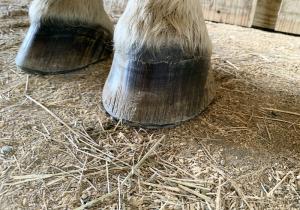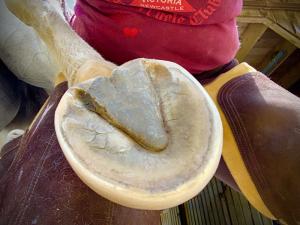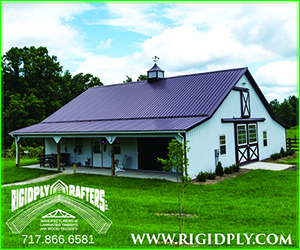By Mary Cour Burrows
When the Mid-South Horse Review asked me to write an article about barefoot trimming, I felt a little overwhelmed because there’s so much information about the hoof, hoof protection, transitioning to barefoot, types of trimming, anatomy, etc. I wasn’t even sure where to start.
So, I’ll start by telling you a little about myself. I’ve been trimming my own horses and those of friends and family for over a decade. Last year, I decided start trimming professionally.
I’m currently pursuing two different trim certifications: one with Progressive Hoof Care practitioners and the other through Ida Hammer’s Whole Horse Trimming, along with extensive seminars with Daisy Bicking and the Northeast Association of Equine Practitioners (NEAEP).
It’s been a deep dive into the equine distal limbs, but one of my main takeaways so far has been about the importance of good nutrition, and the benefits of the reducing starch, eliminating grain/sugars, and feeding a forage-only based diet with a focus on mineral balancing.
A forage-based, low-starch diet, along with added trace minerals, can have a huge impact on the soundness and structure of the hoof and the overall health of the horse. I know it’s made an enormous impact on my personal horses.
When a diet is properly balanced, issues such as weak hoof integrity virtually disappear. When the diet is properly balanced, I’ve seen significant reduction in shelly, flakey hooves, white line disease, thrush, and weak laminae connection. Trace minerals zinc and copper are especially critical for the integrity of the hoof.
Copper is an essential trace mineral that plays a vital role in many processes within your horse’s body. There are copper-dependent enzymes involved in the synthesis and maintenance of elastic connective tissue. The enzyme Lysol Oxidase uses copper to cross-link collagen and elastin in connective tissues. Copper is vital for the integrity of connective tissue as well as the formation of new bone. Copper is necessary for the mobilization of stored iron in the body and also detoxifies superoxide, a compound deployed by the immune system to kill invading microorganisms. If that wasn’t enough, copper plays a role in energy production in the horse’s body; if the horse is deficient in copper, it can impact her overall performance. Horses deficient in this trace mineral fade easily in the sun and can experience a dry reddish sun-bleached look to their coats, manes and tails.
Zinc is another mineral extremely important to the integrity of the hoof. It’s present in high concentrations in normal hoof tissue and is crucial for a variety of functions. The mineral is incorporated into zinc finger proteins and is required for cell multiplication and cell maturation into a keratinocyte, and for interactions between various proteins, such as the assembly of keratin, which makes up the hoof wall.
Deficiencies in these minerals can show up in the hoof in a variety of ways, including slow hoof growth, thin shelly walls with mico-cracks, frail connections, and weak horn. When the hoof is weak on a cellular and structural level, it’s more vulnerable to attack from organisms, as even tiny micro breaks will allow microbes such as thrush to enter.
But too much of a mineral can also be a problem. Excess iron cancels the absorption of copper and zinc, even if there is an adequate amount of these minerals available. Excess iron can lead to many problems, including predisposition to infection, predisposition to arthritis, and increased risk of tendon and ligament problems, as well as liver disease and altered glucose metabolism, including insulin resistance and diabetes.
Our soil and water in the Mid-South tend to be high in iron. Even if your horses are getting the recommend amounts of copper and zinc in a commercial feed, excess iron could be cancelling it out. It’s important not to feed anything with added iron or to use the red mineral blocks sold for horses. Excess iron in a horse’s diet can cause significant issues in overall health.
What’s the good news? It’s actually pretty simple and cost effective to balance your horse’s diet. Horse owners spend hundreds of dollars a month feeding large amounts of grains and starch as well as unnecessary supplements. You can achieve better results by simplifying the diet and just giving the horse exactly what she needs instead of pouring on the supplements.
Ideally, the first step is to have your hay analyzed. I like Equi-Analytical Laboratory Services, which specializes in determining the nutrient content of forage and feed for horse owners. They have a comprehensive website [equi-analytical.com] with quite a bit of information about feeds and they offer several reasonably priced packages analyzing your hay.
I also recommend contacting an equine nutritionist and get a custom recommendation for your forage. There are several companies that can do a custom blend of trace minerals.
Dr. Eleanor Kellon [drkellon.com] gives consultations about the nutritional requirements for horses and also offers incredible nutrition courses for equine practitioners and horse owners. Dr. Kellon is currently a staff veterinarian for Uckele Health and Nutrition, Inc.
Another nutritionist who does a custom mineral calculation for your horse based on your forage is Kathleen Gustafson with Great Plains Forage Balance katmando@kc.rr.com. It costs between 60-100 dollars to get a diet recommendation specifically tailored for your horse.
I use a pre-blended mineral balancer called California Trace Plus pellets that meets the requirements for my hay. It contains has Brewer’s yeast for B vitamin as well as Vitamin E. The company is very helpful on the phone and will make custom mixes. (They don’t sponsor me, but I do swear by their service and product!) Visit: https://www.californiatrace.com/.
Another good resource for this area is K. I. S. Trace (Keep It Simple) which has a nice amino acid profile and biotin and is available at https://thornebottomfarm.com/.
I mix my minerals with Timothy grass pellets (low starch) as a carrier with one cup of ground flax for Omega-3 fats. I have plain white salt available all the time and that is it. It’s what I’ve been recommending to most of my trim clients, too. With amazing results!
If you’re looking for more information about feeding the hoof and hoof health, a great place to start is Pete Ramey’s “Feeding the Hoof:” https://www.hoofrehab.com/Diet.html (updated 2018). He has some excellent information and links to other resources if you want to further explore the diet-hoof connection.
I believe that we owe it to our horses to be educated horse owners and keep them as healthy and happy as possible. A great trim and a knowledgeable hoof care provider are important parts of a healthy hoof, but only a part of it. Building a healthy hoof from the inside out is equally important – it’s the cornerstone to horse hoof health and future lifetime soundness.
When the Mid-South Horse Review asked me to write an article about barefoot trimming, I felt a little overwhelmed because there’s so much information about the hoof, hoof protection, transitioning to barefoot, types of trimming, anatomy, etc. I wasn’t even sure where to start.
So, I’ll start by telling you a little about myself. I’ve been trimming my own horses and those of friends and family for over a decade. Last year, I decided start trimming professionally.
I’m currently pursuing two different trim certifications: one with Progressive Hoof Care practitioners and the other through Ida Hammer’s Whole Horse Trimming, along with extensive seminars with Daisy Bicking and the Northeast Association of Equine Practitioners (NEAEP).
It’s been a deep dive into the equine distal limbs, but one of my main takeaways so far has been about the importance of good nutrition, and the benefits of the reducing starch, eliminating grain/sugars, and feeding a forage-only based diet with a focus on mineral balancing.
A forage-based, low-starch diet, along with added trace minerals, can have a huge impact on the soundness and structure of the hoof and the overall health of the horse. I know it’s made an enormous impact on my personal horses.
When a diet is properly balanced, issues such as weak hoof integrity virtually disappear. When the diet is properly balanced, I’ve seen significant reduction in shelly, flakey hooves, white line disease, thrush, and weak laminae connection. Trace minerals zinc and copper are especially critical for the integrity of the hoof.
Copper is an essential trace mineral that plays a vital role in many processes within your horse’s body. There are copper-dependent enzymes involved in the synthesis and maintenance of elastic connective tissue. The enzyme Lysol Oxidase uses copper to cross-link collagen and elastin in connective tissues. Copper is vital for the integrity of connective tissue as well as the formation of new bone. Copper is necessary for the mobilization of stored iron in the body and also detoxifies superoxide, a compound deployed by the immune system to kill invading microorganisms. If that wasn’t enough, copper plays a role in energy production in the horse’s body; if the horse is deficient in copper, it can impact her overall performance. Horses deficient in this trace mineral fade easily in the sun and can experience a dry reddish sun-bleached look to their coats, manes and tails.
Zinc is another mineral extremely important to the integrity of the hoof. It’s present in high concentrations in normal hoof tissue and is crucial for a variety of functions. The mineral is incorporated into zinc finger proteins and is required for cell multiplication and cell maturation into a keratinocyte, and for interactions between various proteins, such as the assembly of keratin, which makes up the hoof wall.
Deficiencies in these minerals can show up in the hoof in a variety of ways, including slow hoof growth, thin shelly walls with mico-cracks, frail connections, and weak horn. When the hoof is weak on a cellular and structural level, it’s more vulnerable to attack from organisms, as even tiny micro breaks will allow microbes such as thrush to enter.
But too much of a mineral can also be a problem. Excess iron cancels the absorption of copper and zinc, even if there is an adequate amount of these minerals available. Excess iron can lead to many problems, including predisposition to infection, predisposition to arthritis, and increased risk of tendon and ligament problems, as well as liver disease and altered glucose metabolism, including insulin resistance and diabetes.
Our soil and water in the Mid-South tend to be high in iron. Even if your horses are getting the recommend amounts of copper and zinc in a commercial feed, excess iron could be cancelling it out. It’s important not to feed anything with added iron or to use the red mineral blocks sold for horses. Excess iron in a horse’s diet can cause significant issues in overall health.
What’s the good news? It’s actually pretty simple and cost effective to balance your horse’s diet. Horse owners spend hundreds of dollars a month feeding large amounts of grains and starch as well as unnecessary supplements. You can achieve better results by simplifying the diet and just giving the horse exactly what she needs instead of pouring on the supplements.
Ideally, the first step is to have your hay analyzed. I like Equi-Analytical Laboratory Services, which specializes in determining the nutrient content of forage and feed for horse owners. They have a comprehensive website [equi-analytical.com] with quite a bit of information about feeds and they offer several reasonably priced packages analyzing your hay.
I also recommend contacting an equine nutritionist and get a custom recommendation for your forage. There are several companies that can do a custom blend of trace minerals.
Dr. Eleanor Kellon [drkellon.com] gives consultations about the nutritional requirements for horses and also offers incredible nutrition courses for equine practitioners and horse owners. Dr. Kellon is currently a staff veterinarian for Uckele Health and Nutrition, Inc.
Another nutritionist who does a custom mineral calculation for your horse based on your forage is Kathleen Gustafson with Great Plains Forage Balance katmando@kc.rr.com. It costs between 60-100 dollars to get a diet recommendation specifically tailored for your horse.
I use a pre-blended mineral balancer called California Trace Plus pellets that meets the requirements for my hay. It contains has Brewer’s yeast for B vitamin as well as Vitamin E. The company is very helpful on the phone and will make custom mixes. (They don’t sponsor me, but I do swear by their service and product!) Visit: https://www.californiatrace.com/.
Another good resource for this area is K. I. S. Trace (Keep It Simple) which has a nice amino acid profile and biotin and is available at https://thornebottomfarm.com/.
I mix my minerals with Timothy grass pellets (low starch) as a carrier with one cup of ground flax for Omega-3 fats. I have plain white salt available all the time and that is it. It’s what I’ve been recommending to most of my trim clients, too. With amazing results!
If you’re looking for more information about feeding the hoof and hoof health, a great place to start is Pete Ramey’s “Feeding the Hoof:” https://www.hoofrehab.com/Diet.html (updated 2018). He has some excellent information and links to other resources if you want to further explore the diet-hoof connection.
I believe that we owe it to our horses to be educated horse owners and keep them as healthy and happy as possible. A great trim and a knowledgeable hoof care provider are important parts of a healthy hoof, but only a part of it. Building a healthy hoof from the inside out is equally important – it’s the cornerstone to horse hoof health and future lifetime soundness.






![Paso Fino Pleasure_Amateur Owner [Class 650]](https://midsouthhorsereview.com/old website/admin/files/news_7571_small_bJaEKlV8.jpg)




